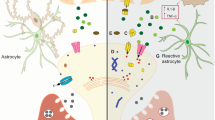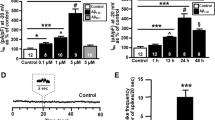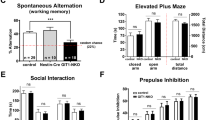Abstract
Cognitive impairments are a major clinical feature of the common neurogenetic disease neurofibromatosis type 1 (NF1). Previous studies have demonstrated that increased neuronal inhibition underlies the learning deficits in NF1, however, the molecular mechanism underlying this cell-type specificity has remained unknown. Here, we identify an interneuron-specific attenuation of hyperpolarization-activated cyclic nucleotide-gated (HCN) current as the cause for increased inhibition in Nf1 mutants. Mechanistically, we demonstrate that HCN1 is a novel NF1-interacting protein for which loss of NF1 results in a concomitant increase of interneuron excitability. Furthermore, the HCN channel agonist lamotrigine rescued the electrophysiological and cognitive deficits in two independent Nf1 mouse models, thereby establishing the importance of HCN channel dysfunction in NF1. Together, our results provide detailed mechanistic insights into the pathophysiology of NF1-associated cognitive defects, and identify a novel target for clinical drug development.
This is a preview of subscription content, access via your institution
Access options
Subscribe to this journal
Receive 12 print issues and online access
$259.00 per year
only $21.58 per issue
Buy this article
- Purchase on Springer Link
- Instant access to full article PDF
Prices may be subject to local taxes which are calculated during checkout





Similar content being viewed by others
References
Krab LC, Aarsen FK, de Goede-Bolder A, Catsman-Berrevoets CE, Arts WF, Moll HA et al. Impact of neurofibromatosis type 1 on school performance. J Child Neurol 2008; 23: 1002–1010.
Hyman SL, Shores A, North KN . The nature and frequency of cognitive deficits in children with neurofibromatosis type 1. Neurology 2005; 65: 1037–1044.
Costa RM, Federov NB, Kogan JH, Murphy GG, Stern J, Ohno M et al. Mechanism for the learning deficits in a mouse model of neurofibromatosis type 1. Nature 2002; 415: 526–530.
Silva AJ, Frankland PW, Marowitz Z, Friedman E, Laszlo GS, Cioffi D et al. A mouse model for the learning and memory deficits associated with neurofibromatosis type I. Nat Genet 1997; 15: 281–284.
van der Vaart T, van Woerden GM, Elgersma Y, de Zeeuw CI, Schonewille M . Motor deficits in neurofibromatosis type 1 mice: the role of the cerebellum. Genes Brain Behav 2011; 10: 404–409.
Cui Y, Costa RM, Murphy GG, Elgersma Y, Zhu Y, Gutmann DH et al. Neurofibromin regulation of ERK signaling modulates GABA release and learning. Cell 2008; 135: 549–560.
Ye X, Carew TJ . Small G protein signaling in neuronal plasticity and memory formation: the specific role of ras family proteins. Neuron 2010; 68: 340–361.
Krab LC, de Goede-Bolder A, Aarsen FK, Pluijm SM, Bouman MJ, van der Geest JN et al. Effect of simvastatin on cognitive functioning in children with neurofibromatosis type 1: a randomized controlled trial. JAMA 2008; 300: 287–294.
van der Vaart T, Plasschaert E, Rietman AB, Renard M, Oostenbrink R, Vogels A et al. Simvastatin for cognitive deficits and behavioural problems in patients with neurofibromatosis type 1 (NF1-SIMCODA): a randomised, placebo-controlled trial. Lancet Neurol 2013; 12: 1076–1083.
Geist RT, Gutmann DH . Expression of a developmentally-regulated neuron-specific isoform of the neurofibromatosis 1 (NF1) gene. Neurosci Lett 1996; 211: 85–88.
Gutmann DH, Zhang Y, Hirbe A . Developmental regulation of a neuron-specific neurofibromatosis 1 isoform. Ann Neurol 1999; 46: 777–782.
Danglot G, Regnier V, Fauvet D, Vassal G, Kujas M, Bernheim A . Neurofibromatosis 1 (NF1) mRNAs expressed in the central nervous system are differentially spliced in the 5' part of the gene. Hum Mole Genet 1995; 4: 915–920.
Wahl-Schott C, Biel M . HCN channels: structure, cellular regulation and physiological function. Cell Mol Life Sci 2009; 66: 470–494.
Maccaferri G, McBain CJ . The hyperpolarization-activated current (Ih) and its contribution to pacemaker activity in rat CA1 hippocampal stratum oriens-alveus interneurones. J Physiol 1996; 497: 119–130.
Lupica CR, Bell JA, Hoffman AF, Watson PL . Contribution of the hyperpolarization-activated current (I(h)) to membrane potential and GABA release in hippocampal interneurons. J Neurophysiol 2001; 86: 261–268.
Magee JC . Dendritic Ih normalizes temporal summation in hippocampal CA1 neurons. Nat Neurosci 1999; 2: 848.
Nolan MF, Malleret G, Dudman JT, Buhl DL, Santoro B, Gibbs E et al. A behavioral role for dendritic integration: HCN1 channels constrain spatial memory and plasticity at inputs to distal dendrites of CA1 pyramidal neurons. Cell 2004; 119: 719–732.
Wang M, Ramos BP, Paspalas CD, Shu Y, Simen A, Duque A et al. Alpha2A-adrenoceptors strengthen working memory networks by inhibiting cAMP-HCN channel signaling in prefrontal cortex. Cell 2007; 129: 397–410.
Brager DH, Akhavan AR, Johnston D . Impaired dendritic expression and fmr1(-) (/y) plasticity of h-channels in the mouse model of fragile X syndrome. Cell Rep 2012; 1: 225–233.
Shah MM, Anderson AE, Leung V, Lin X, Johnston D . Seizure-induced plasticity of h channels in entorhinal cortical layer III pyramidal neurons. Neuron 2004; 44: 495–508.
Fan Y, Fricker D, Brager DH, Chen X, Lu HC, Chitwood RA et al. Activity-dependent decrease of excitability in rat hippocampal neurons through increases in I(h). Nat Neurosci 2005; 8: 1542–1551.
Notomi T, Shigemoto R . Immunohistochemical localization of Ih channel subunits, HCN1-4, in the rat brain. J Comp Neurol 2004; 471: 241–276.
Bender RA, Brewster A, Santoro B, Ludwig A, Hofmann F, Biel M et al. Differential and age-dependent expression of hyperpolarization-activated, cyclic nucleotide-gated cation channel isoforms 1-4 suggests evolving roles in the developing rat hippocampus. Neuroscience 2001; 106: 689–698.
Brewster AL, Chen Y, Bender RA, Yeh A, Shigemoto R, Baram TZ . Quantitative analysis and subcellular distribution of mRNA and protein expression of the hyperpolarization-activated cyclic nucleotide-gated channels throughout development in rat hippocampus. Cereb Cortex 2007; 17: 702–712.
Sugino K, Hempel CM, Miller MN, Hattox AM, Shapiro P, Wu C et al. Molecular taxonomy of major neuronal classes in the adult mouse forebrain. Nat Neurosci 2006; 9: 99–107.
Zeng H, Shen EH, Hohmann JG, Oh SW, Bernard A, Royall JJ et al. Large-scale cellular-resolution gene profiling in human neocortex reveals species-specific molecular signatures. Cell 2012; 149: 483–496.
van Woerden GM, Harris KD, Hojjati MR, Gustin RM, Qiu S, de Avila Freire R et al. Rescue of neurological deficits in a mouse model for Angelman syndrome by reduction of alphaCaMKII inhibitory phosphorylation. Nat Neurosci 2007; 10: 280–282.
Ozonoff S . Cognitive impairment in neurofibromatosis type 1. Am J Med Genet 1999; 89: 45–52.
Li W, Cui Y, Kushner SA, Brown RA, Jentsch JD, Frankland PW et al. The HMG-CoA reductase inhibitor lovastatin reverses the learning and attention deficits in a mouse model of neurofibromatosis type 1. Curr Biol 2005; 15: 1961–1967.
Larson J, Wong D, Lynch G . Patterned stimulation at the theta frequency is optimal for the induction of hippocampal long-term potentiation. Brain Res 1986; 368: 347–350.
Chapman CA, Perez Y, Lacaille JC . Effects of GABA(A) inhibition on the expression of long-term potentiation in CA1 pyramidal cells are dependent on tetanization parameters. Hippocampus 1998; 8: 289–298.
Bollag G, McCormick F, Clark R . Characterization of full-length neurofibromin: tubulin inhibits Ras GAP activity. EMBO J 1993; 12: 1923–1927.
Gregory PE, Gutmann DH, Mitchell A, Park S, Boguski M, Jacks T et al. Neurofibromatosis type 1 gene product (neurofibromin) associates with microtubules. Somat Cell Mol Genet 1993; 19: 265–274.
Poolos NP, Migliore M, Johnston D . Pharmacological upregulation of h-channels reduces the excitability of pyramidal neuron dendrites. Nat Neurosci 2002; 5: 767–774.
Molosh AI, Johnson PL, Spence JP, Arendt D, Federici LM, Bernabe C et al. Social learning and amygdala disruptions in Nf1 mice are rescued by blocking p21-activated kinase. Nat Neurosci 2014; 17: 1583–1590.
Shilyansky C, Karlsgodt KH, Cummings DM, Sidiropoulou K, Hardt M, James AS et al. Neurofibromin regulates corticostriatal inhibitory networks during working memory performance. Proc Natl Acad Sci USA 2010; 107: 13141–13146.
Lee S, Hjerling-Leffler J, Zagha E, Fishell G, Rudy B . The largest group of superficial neocortical GABAergic interneurons expresses ionotropic serotonin receptors. J Neurosci 2010; 30: 16796–16808.
Rudy B, Fishell G, Lee S, Hjerling-Leffler J . Three groups of interneurons account for nearly 100% of neocortical GABAergic neurons. Deve Neurobiol 2011; 71: 45–61.
Pawelzik H, Hughes DI, Thomson AM . Physiological and morphological diversity of immunocytochemically defined parvalbumin- and cholecystokinin-positive interneurones in CA1 of the adult rat hippocampus. J Comp Neurol 2002; 443: 346–367.
Schuhmacher AJ, Guerra C, Sauzeau V, Canamero M, Bustelo XR, Barbacid M . A mouse model for Costello syndrome reveals an Ang II-mediated hypertensive condition. J Clin Invest 2008; 118: 2169–2179.
Poolos NP, Bullis JB, Roth MK . Modulation of h-channels in hippocampal pyramidal neurons by p38 mitogen-activated protein kinase. J Neurosci 2006; 26: 7995–8003.
Kuo CC, Lu L . Characterization of lamotrigine inhibition of Na+ channels in rat hippocampal neurones. Br J Pharmacol 1997; 121: 1231–1238.
Xie X, Lancaster B, Peakman T, Garthwaite J . Interaction of the antiepileptic drug lamotrigine with recombinant rat brain type IIA Na+ channels and with native Na+ channels in rat hippocampal neurones. Pflugers Archiv: Eur J Physiol 1995; 430: 437–446.
Krab LC, de Goede-Bolder A, Aarsen FK, Moll HA, De Zeeuw CI, Elgersma Y et al. Motor learning in children with neurofibromatosis type I. Cerebellum 2011; 10: 14–21.
Miles R, Toth K, Gulyas AI, Hajos N, Freund TF . Differences between somatic and dendritic inhibition in the hippocampus. Neuron 1996; 16: 815–823.
Soltesz I, Smetters DK, Mody I . Tonic inhibition originates from synapses close to the soma. Neuron 1995; 14: 1273–1283.
Brager DH, Johnston D . Plasticity of intrinsic excitability during long-term depression is mediated through mGluR-dependent changes in I(h) in hippocampal CA1 pyramidal neurons. J Neurosci 2007; 27: 13926–13937.
George MS, Abbott LF, Siegelbaum SA . HCN hyperpolarization-activated cation channels inhibit EPSPs by interactions with M-type K(+) channels. Nat Neurosci 2009; 12: 577–584.
Tsay D, Dudman JT, Siegelbaum SA . HCN1 channels constrain synaptically evoked Ca2+ spikes in distal dendrites of CA1 pyramidal neurons. Neuron 2007; 56: 1076–1089.
Lee YS, Ehninger D, Zhou M, Oh JY, Kang M, Kwak C et al. Mechanism and treatment for learning and memory deficits in mouse models of Noonan syndrome. Nat Neurosci 2014; 17: 1736–1743.
Brown JA, Gianino SM, Gutmann DH . Defective cAMP generation underlies the sensitivity of CNS neurons to neurofibromatosis-1 heterozygosity. J Neurosci 2010; 30: 5579–5589.
The I, Hannigan GE, Cowley GS, Reginald S, Zhong Y, Gusella JF et al. Rescue of a Drosophila NF1 mutant phenotype by protein kinase A. Science 1997; 276: 791–794.
Tong J, Hannan F, Zhu Y, Bernards A, Zhong Y . Neurofibromin regulates G protein-stimulated adenylyl cyclase activity. Nat Neurosci 2002; 5: 95–96.
Stowe IB, Mercado EL, Stowe TR, Bell EL, Oses-Prieto JA, Hernandez H et al. A shared molecular mechanism underlies the human rasopathies Legius syndrome and Neurofibromatosis-1. Genes Dev 2012; 26: 1421–1426.
Acknowledgements
We thank Dr Nolan for providing the HCN-KO brain samples, Dr Chetkovich for the guinea pig HCN1 antibody, Dr Siegelbaum for the HCN1 constructs, Dr Guerra and Dr Barbacid for the H-RasG12V mice, and TEVA Pharmaceuticals for providing LTG. We are grateful to the following people for their assistance: M Aghadavoud Jolfaei (field-recording and genotyping), E Haasdijk and E Goedknegt (immunohistochemistry), M Elgersma, U Unmehopa and D Swaab (in-situ hybridizations), RC van der Schors (mass spectrometry), Kelly Diggs-Andrews (NF1 western blot) and R Bari (cloning Nf1 9a gene). We thank Gerard Borst for advice and critical reading of the manuscript. This work was supported by a Children Tumor Foundation (CTF) young investigator award to AO, by grants from the Netherlands Brain Foundation (HsN) and NWO-ZonMW (VICI) to YE, a Department of Defense grant to DHG, HEALTH-2009-2.1.2-1 EU-FP7 SYNSYS to ABS and KWL, and a FES-NEUROBASIC grant to CNL, ABS, SAK and YE.
Author Contributions
AO conducted electrophysiology experiments, immunohistochemistry and data analysis. YE generated the Nf19a–/9a– mouse in the laboratory of AJS. TvdV carried out behavioral experiments and data analysis. GvW and EM performed biochemical experiments and immunohistochemistry. MRH contributed to field-potential recordings. KWL conducted proteomics experiments and data analysis. DHG, ABS, CNL and AJS provided critical insight and reagents. AO, SAK and YE designed the study and wrote the manuscript with input from all authors.
Author information
Authors and Affiliations
Corresponding author
Ethics declarations
Competing interests
The authors declare no conflict of interest.
Additional information
Supplementary Information accompanies the paper on the Molecular Psychiatry website
Supplementary information
Rights and permissions
About this article
Cite this article
Omrani, A., van der Vaart, T., Mientjes, E. et al. HCN channels are a novel therapeutic target for cognitive dysfunction in Neurofibromatosis type 1. Mol Psychiatry 20, 1311–1321 (2015). https://doi.org/10.1038/mp.2015.48
Received:
Revised:
Accepted:
Published:
Issue Date:
DOI: https://doi.org/10.1038/mp.2015.48
This article is cited by
-
Improvement of synaptic plasticity and cognitive function in RASopathies—a monocentre, randomized, double-blind, parallel-group, placebo-controlled, cross-over clinical trial (SynCoRAS)
Trials (2023)
-
Novel therapeutic perspectives in Noonan syndrome and RASopathies
European Journal of Pediatrics (2023)
-
Neuronal hyperexcitability drives central and peripheral nervous system tumor progression in models of neurofibromatosis-1
Nature Communications (2022)
-
MEK inhibition ameliorates social behavior phenotypes in a Spred1 knockout mouse model for RASopathy disorders
Molecular Autism (2021)
-
Guanfacine treatment improves ADHD phenotypes of impulsivity and hyperactivity in a neurofibromatosis type 1 mouse model
Journal of Neurodevelopmental Disorders (2020)



